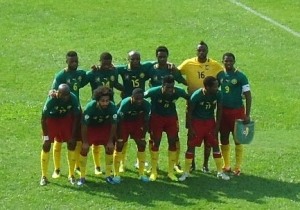It’s time for the Indomitable Lions of Cameroon to talk on the pitch. In a few hours they will be facing the El Tri of Mexico. What should fans expect from the current pack of Lions?
Tactics: 4-5-1 or 4-3-3
Head coach Volker Finke has mainly used a 4-3-3 formation since he took over. However, there have been games where the Lions played more as a 4-2-3-1 with a double-pivot in central midfield and, in at least one instance their shape was close to a 4-4-2 diamond.
I expect the Lions to show up as a tight unit in a 4-3-3 when attacking and 4-5-1 once they lose possession of the ball. The latter would be the default posture taken by the team which will be very defensive in outlook.
The central midfield trio will look to charge down on the Mexicans, with a lot of energy to disrupt their movement. When in 4-3-3 mode the forwards will bear down on Mexico’s central defensive trio.
When the ball is lost the wide forwards will drop into midfield to block the flanks and serve as the first line of defense. They will not hesitate to drop very deep if necessary and break with speed once the Mexican attack is contained.
Cameroon played a high defensive line in all of its pre-World Cup warm-up matches. The idea is to keep the opposing attackers closer to the midfield than in the Lions’ danger area. The disadvantage though, is that if the defenders are not tactically disciplined or one member loses concentration, the impact can be devastating. How they manage to switch-on immediately the game starts in each half; and their This, concentration at the end of the halves, are points to watch. These have been the team’s weaknesses in the recent past.
As much as Cameroon will depend on counter-attacks, Mexico must also be wary of the Lions’ passing game forged by coach Finke. It is an interesting blend reminiscent of the 1990 generation that reached the quarter-finals. The player profiles and tactics are similar and they may stun Mexico as they did Diego Maradona’s Argentina.
Back to 1990
In 1990, Cameroon often started in a 4-5-1 formation. Emmanuel Kunde sat in front of the back 4. He intercepted attacks but also had the vision to make forward passes. In the current team, that role has been handed to Alex Song, who not only wears the number six jersey like Kunde but also has the ability to play in central defence and in midfield. Should Song be unable to start, Joel Matip would step into the Kunde shoes.
Two other players supported gave the midfield steel and penetration in 1990: Emile Mbouh and Andre Kana Biyick. The former was the grafter – who would stop at nothing to get the ball, with an ability to play an energetic game for 90 -minutes. That role in the current squad is held by Eyong Enoh Takang. He is the one player who has started and completed every game since Volker Finke took over in May 2013. His is an ungrateful task of fixing the errors of his teammates without looking like the hero. Cameroon’s success depends on him being on song.
The Kana Biyick role will surely be handed to Stephane Mbia. Kana Biyick could play almost anywhere. He was a good centre-back but hated to play in that position. He could play as a box-to-box midfielder in a double pivot but could also feature as a support striker when called upon to do so. Since he got into Cameroon’s senior squad, Stephane Mbia has played as right-back, centre-back, holding midfielder, relay midfielder and support striker.
Down the flanks in 1990, Cameroon had two of its greatest artistes: Louis Paul Mfede (on the left) and Cyrille Makanaky (on the right). Both could also play as traditional number 10s or support striker if given the opportunity.
Eric Maxim Choupo-Moting will be the current team’s Mfede. A great dribbler who can pass well and score goals. He will keep opposing full-backs in their camp. Cameroon’s success against Mexico and Croatia will depend on his form.
Benjamin Moukandjo has dreadlocks like Makanaky and he also has the pace and tenacity of the 1990 hero. As observed against Germany, Moukandjo can defend and storm forward like a speed train. He also misses a lot of goals like Makanaky – who rarely scored for Cameroon.
Cameroon in 1990 started games with a single out and out forward: Omam Biyick. He scored only one goal in that competition but it was an unforgetable goal (against Argentina). Omam, like Samuel Eto’o today, knew how to create openings for other forwards. Many often judged him in relation to the goals he scored (like they do with Eto’o) but it was his creativity that was one of his biggest assets.

